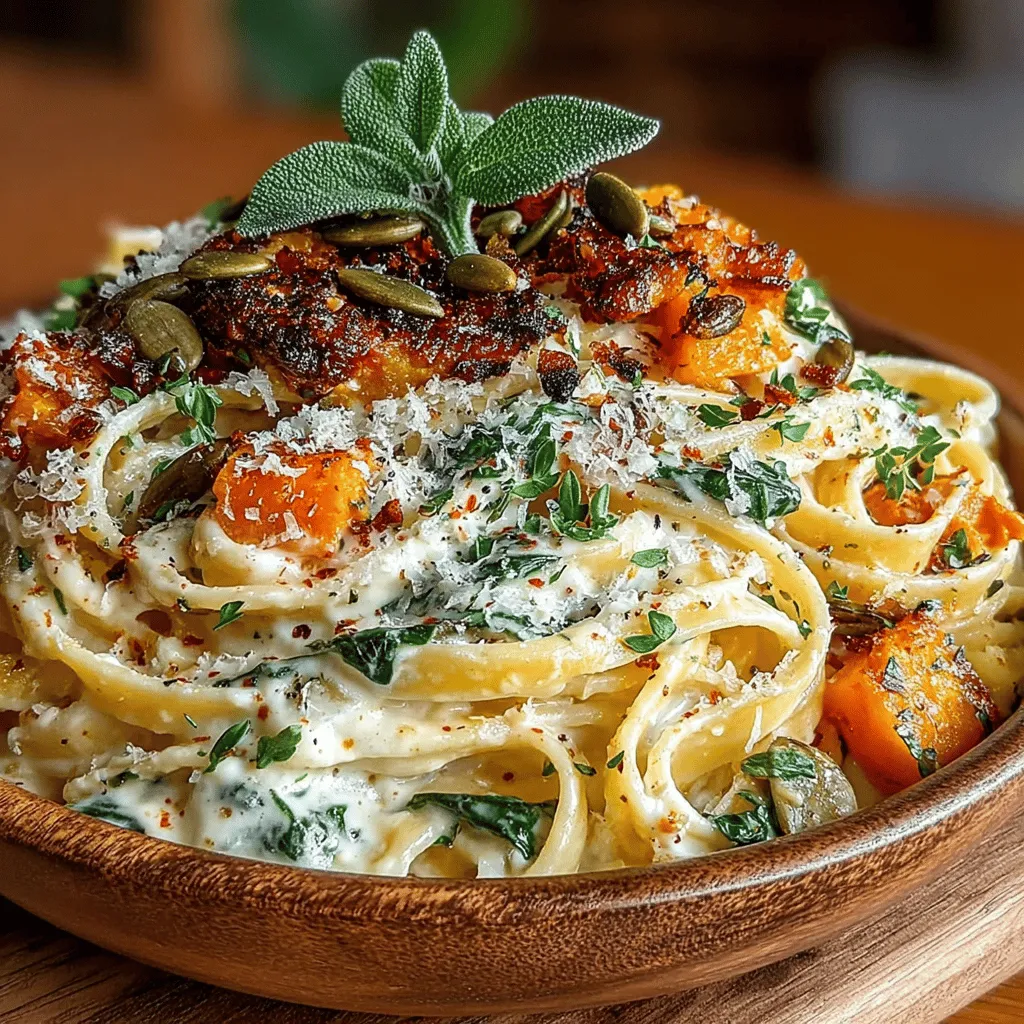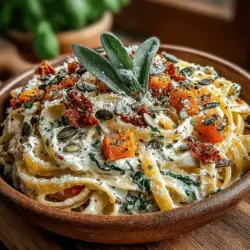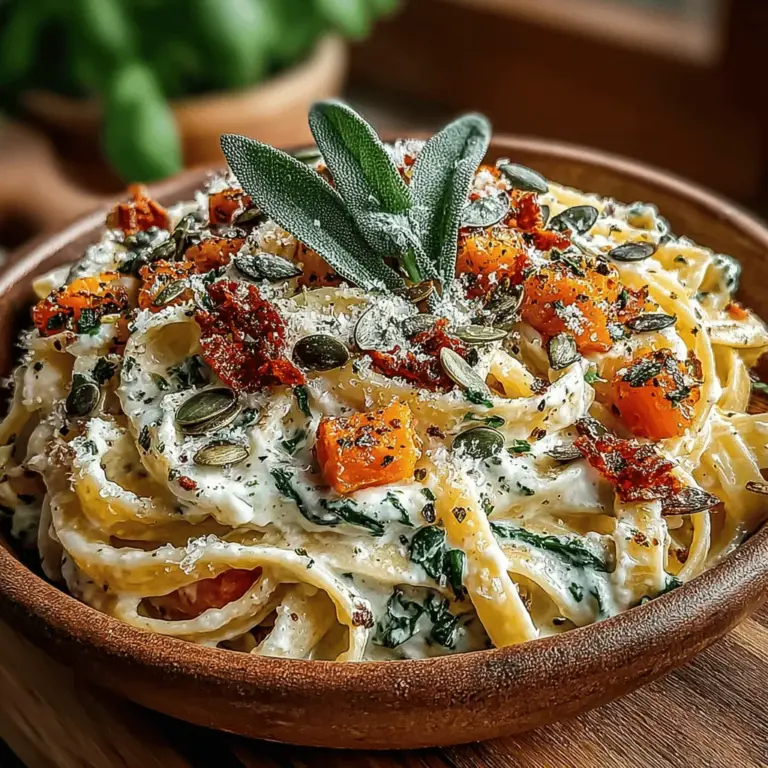As the leaves change color and the air turns crisp, autumn invites us to indulge in heartwarming flavors and comforting meals. One such dish that captures the essence of the season is Savory Butternut Squash & Sage Pasta. This delightful recipe combines the sweet, nutty taste of butternut squash with the fragrant herb sage, resulting in a dish that is not only delicious but also embodies the warmth of fall.
Incorporating fresh, seasonal ingredients is paramount to achieving the best flavors in your cooking. Butternut squash, a staple of autumn harvests, is not only versatile but also packed with nutrients. Similarly, sage adds a distinctive flavor that enhances the overall profile of the dish, making it a perfect match for pasta. Regardless of your dietary preferences, this recipe can be adapted to suit various needs, whether you’re looking for a vegetarian dish, a vegan alternative, or simply a comforting meal to share with loved ones.
In this article, you can expect a comprehensive guide to creating Savory Butternut Squash & Sage Pasta, including a deep dive into its ingredients, their benefits, and a step-by-step recipe to lead you through the cooking process. Let’s embrace the bounty of autumn and discover how to bring this cozy dish to life in your kitchen.
The Allure of Autumn Ingredients
As the season shifts, certain ingredients come into their own, and butternut squash is a star performer. This squash, with its vibrant orange flesh and creamy texture, is often available at local farmers’ markets and grocery stores during autumn. Not only is it a visual delight, but it also boasts a wealth of nutritional benefits. Rich in vitamins A and C, potassium, and fiber, butternut squash is a powerhouse of health benefits that supports immune function and digestive health.
Complementing the squash is sage, an herb that has been celebrated in culinary traditions for centuries. Known for its earthy and slightly peppery flavor, sage pairs beautifully with the sweetness of butternut squash, adding depth and complexity to the dish. The aromatic qualities of sage not only enhance the flavor profile but also contribute to the dish’s overall olfactory appeal, making it a feast for the senses.
Ingredients Overview
To make Savory Butternut Squash & Sage Pasta, you’ll need a few key ingredients. Understanding these components will help you appreciate their roles in the dish and allow for adjustments based on personal preferences or dietary needs.
Pasta Options
When it comes to choosing the pasta for this recipe, you have several options. Fettuccine, linguine, or penne all work well, yet each brings a different texture and mouthfeel to the dish. Fettuccine offers a broader surface area that can catch the sauce beautifully, while penne provides a fun, bite-sized shape that holds the sauce in its tubes. Choose whichever pasta you prefer, or experiment with gluten-free options if needed.
Butternut Squash
Selecting the perfect butternut squash is crucial for this recipe. Look for squashes that feel heavy for their size and have a smooth, firm skin. Avoid any that have soft spots or blemishes. When it comes to preparation, you’ll want to peel the squash, remove the seeds, and cut it into bite-sized cubes. Roasting the squash will bring out its natural sweetness and create a caramelized exterior that adds richness to the dish.
Olive Oil
Olive oil is another important ingredient in this recipe, both for its flavor and health benefits. Rich in monounsaturated fats and antioxidants, olive oil can enhance heart health while providing a luscious base for sautéing your aromatics and roasting the squash. For a more robust flavor, consider using extra virgin olive oil, which is cold-pressed and retains more of the natural flavor profile of the olives.
Aromatics
The foundation of flavor in many dishes lies in its aromatics, and this pasta is no exception. Onions and garlic play a crucial role in building the flavor base. Onions provide sweetness and depth, while garlic adds a sharp, pungent note that complements the other ingredients. When sautéed together, they create a fragrant base that sets the tone for the entire dish.
Cream Options
To create a creamy sauce that binds the pasta and roasted squash together, you’ll have a choice between heavy cream and plant-based alternatives. Heavy cream lends a rich and luxurious mouthfeel, while alternatives like coconut cream or cashew cream can offer a lighter option that is still creamy and satisfying. For those following a vegan diet, plant-based options are a fantastic way to enjoy this dish without compromising on taste or texture.
Cheese Alternatives
Lastly, cheese can elevate the dish, providing an umami kick that rounds out the flavors. Traditional recipes often call for Parmesan cheese, but for a vegan version, nutritional yeast serves as an excellent substitute. It delivers a cheesy flavor without the dairy, making it a staple in many plant-based recipes.
Step-by-Step Recipe Guide
Now that we’ve explored the ingredients, let’s dive into the first steps of preparing your Savory Butternut Squash & Sage Pasta.
Cooking the Pasta to Perfection
Begin by bringing a large pot of salted water to a rolling boil. Salting the water is an important step that enhances the flavor of the pasta as it cooks. Aim for a ratio of about 1 tablespoon of salt for every 4 quarts of water. Once the water is boiling, add your chosen pasta and cook according to the package instructions until it reaches an ideal al dente texture. This typically means the pasta will still have a slight bite to it, which is perfect for holding up against the creamy sauce.
Roasting Butternut Squash
While the pasta cooks, it’s time to focus on the butternut squash. Preheat your oven to 400°F (200°C). Toss the cubed butternut squash in a bowl with olive oil, salt, and pepper. Spread the seasoned cubes evenly on a baking sheet lined with parchment paper. Roasting the squash will take about 25 to 30 minutes, turning halfway through to ensure even cooking. The goal is to achieve a golden-brown caramelization on the edges, which enhances the natural sweetness of the squash and adds a depth of flavor that will elevate your pasta dish.
By carefully selecting your ingredients and following these initial steps, you’re setting the stage for a delightful culinary experience that celebrates the flavors of autumn. As you continue with the recipe, you’ll discover how these components come together to create a harmonious and satisfying meal that’s perfect for the season. Stay tuned for the next part where we’ll dive deeper into combining these elements and finishing your Savory Butternut Squash & Sage Pasta.

Tips for Seasoning and Ensuring Even Roasting
To achieve a deliciously roasted butternut squash, seasoning and even roasting are vital. Start by cutting the squash into uniform cubes, ensuring they roast at the same rate. An optimal size for the cubes is about 1-inch; this allows for caramelization while still maintaining some texture.
When seasoning, don’t shy away from using a generous amount of salt and pepper. The seasoning should enhance the natural sweetness of the squash. A light drizzle of olive oil, combined with salt, pepper, and a pinch of nutmeg, can elevate the flavors significantly. Nutmeg complements butternut squash beautifully, adding depth without overpowering its natural taste.
To ensure even roasting, spread the squash cubes in a single layer on a baking sheet. Avoid overcrowding to allow for proper airflow, which will prevent steaming and help achieve that desirable caramelization. Toss the cubes halfway through roasting to ensure they brown evenly on all sides.
Sautéing Aromatics for Depth of Flavor
Once your squash is roasting, it’s time to build the flavor base for your pasta sauce. Aromatics play a crucial role in creating a delicious depth of flavor. Start by finely chopping an onion and mincing a few cloves of garlic.
The Role of Onion and Garlic in Building a Flavor Base
Onions are essential for adding sweetness and savoriness to dishes, while garlic contributes a pungent aroma and flavor that enhances any recipe. Begin by heating a tablespoon of olive oil in a large skillet over medium heat.
Timing and Techniques for Sautéing to Prevent Burning
Add the chopped onion first, allowing it to soften and become translucent, which should take about 5-7 minutes. Stir occasionally to prevent burning. Once the onion is tender, add the minced garlic, cooking for an additional 1-2 minutes until fragrant. Be cautious; garlic can burn quickly and turn bitter if sautéed for too long.
How to Incorporate Sage and Red Pepper Flakes for Aromatic Enhancement
Sage is a traditional herb that pairs beautifully with butternut squash. Once the garlic is aromatic, introduce chopped fresh sage leaves and a pinch of red pepper flakes to the pan. The sage will release its earthy aroma, while the red pepper flakes will add a subtle heat that balances the sweetness of the squash.
Combining Ingredients for the Perfect Sauce
After the squash has roasted and your aromatic mixture is ready, it’s time to bring everything together.
The Importance of Simmering for Flavor Melding
Transfer the roasted butternut squash into the skillet with the sautéed onion, garlic, and herbs. Stir to combine and allow the mixture to simmer for about 5 minutes. This simmering step is crucial as it allows the flavors to meld, creating a harmonious sauce.
Adjusting Sauce Consistency with Reserved Pasta Water
As you cook your pasta, be sure to reserve some of the pasta water before draining. This starchy water can be the secret ingredient for achieving the perfect sauce consistency. If your sauce appears too thick, gradually add a few tablespoons of the reserved pasta water until you reach your desired texture.
Balancing Flavors: Seasoning Tips with Salt and Pepper
Taste your sauce before serving. With the sweetness of the squash and the warmth of the spices, you may find it needs a little more seasoning. Adjust with salt and pepper as needed to bring out the flavors.
Final Assembly: Bringing the Dish Together
Now that your sauce is ready, it’s time for the final assembly.
Techniques for Coating Pasta with Sauce Effectively
Add the cooked pasta directly into the skillet with the sauce. Use tongs to gently toss the pasta, ensuring that every strand is coated with the rich sauce. If the pasta seems dry, add more reserved pasta water as necessary.
Incorporating Cheese Alternatives for a Creamy Texture
For a creamy finish, consider adding a cheese alternative. Nutritional yeast is a fantastic option for vegans, providing a cheesy flavor without dairy. Alternatively, a sprinkle of Parmesan cheese can add richness if you’re not avoiding dairy. Stir this in just before serving, allowing it to melt slightly and blend with the sauce.
Presentation Tips for an Inviting Serving
When plating your dish, consider using wide, shallow bowls to showcase the pasta beautifully. Garnish with a sprinkle of fresh sage leaves and a drizzle of olive oil for an appetizing presentation. You can also add toasted pumpkin seeds for an added crunch and nutty flavor.
Serving Suggestions
Pair this savory butternut squash and sage pasta with complementary sides to create a well-rounded meal.
Ideal Pairings for the Pasta Dish
A crisp arugula salad with a light vinaigrette is a perfect accompaniment, providing a refreshing contrast to the rich pasta. Additionally, roasted Brussels sprouts or sautéed greens, like kale or spinach, can enhance the meal’s nutrition and flavor profile.
Garnishing Options: Fresh Sage Leaves and Toasted Pumpkin Seeds
For garnishing, consider adding a few fresh sage leaves on top for a pop of color and flavor. Toasted pumpkin seeds not only add crunch but also contribute an earthy note that harmonizes with the squash.
Suggestions for Side Dishes or Salads to Complement the Meal
For a heartier side, consider serving warm crusty bread or garlic bread to soak up any leftover sauce. If you want a heartier salad, a quinoa salad with cranberries and nuts can also be a delightful addition.
Storage and Reheating Instructions
Best Practices for Storing Leftovers
If you have leftovers, allow the pasta to cool completely before transferring it to an airtight container. This will help preserve the flavors and textures. The dish can be stored in the refrigerator for up to three days.
Tips for Reheating Without Compromising Texture and Flavor
When reheating, add a splash of water or olive oil to prevent the pasta from drying out. Heat it in a skillet over low heat, stirring occasionally until warmed through. Alternatively, you can microwave it in short intervals, stirring in between, until hot.
Ideas for Repurposing Leftovers into New Meals
Leftover pasta can be creatively repurposed into a pasta bake. Combine it with additional vegetables and cheese, then bake until bubbly for a new twist. Alternatively, toss it into a savory frittata for a hearty breakfast option.
Conclusion
This savory butternut squash and sage pasta is a must-try for anyone looking to embrace the flavors of fall. Its unique combination of sweet roasted squash, aromatic herbs, and creamy textures creates a dish that is both comforting and satisfying.
Embrace seasonal cooking by experimenting with flavors and ingredients that reflect the time of year. Cooking is not just about nourishment; it’s about sharing hearty meals with loved ones and creating memories around the dinner table. So gather your ingredients, follow this recipe, and enjoy the joy of cooking and sharing a delicious meal with others. Your kitchen will be filled with warmth and delightful aromas, making it a perfect gathering spot for family and friends.

